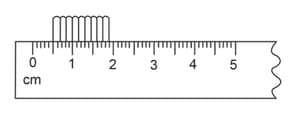NCERT Solutions for Chapter: Motion and Measurement of Distances, Exercise 1: Exercise
NCERT Science Solutions for Exercise - NCERT Solutions for Chapter: Motion and Measurement of Distances, Exercise 1: Exercise
Attempt the practice questions on Chapter 10: Motion and Measurement of Distances, Exercise 1: Exercise with hints and solutions to strengthen your understanding. Science Textbook of Competency Based Questions for Class VI solutions are prepared by Experienced Embibe Experts.
Questions from NCERT Solutions for Chapter: Motion and Measurement of Distances, Exercise 1: Exercise with Hints & Solutions
Dev is a -year-old, studying in 6th class, and has a younger brother, Surya, whose age is - years. Surya is playing by dipping balls in the water tub. Dev observed that the level of the water increased when Surya started dipping the balls one after the other in the water. Then Dev remembered his 6th class topic measurement of volume. He poured water up to the brim of the tub and set up another bigger tub at the bottom of the first tub. He then asked his brother Surya to dip ten identical balls in it so that the overflowed water was collected in the tub at the bottom. Dev calculated the volume of overflowed water and found that it was . Dev calculated the volume of each ball. Which of the following options matches with Dev's calculation?
Find the correct arrangement of the following steps in sequence to find the volume of an irregular shaped solid body.
(A) The irregular shaped solid is tied with the thread and is lowered into the measuring scale.
(B) Take a measuring cylinder with graduations in millimeters
(C) The level of water in the measuring cylinder rises after immersion of solid(say )
(D) First it is filled with water to a certain level or volume (say )
(E) The volume of stone is equal tot the difference between the volume of the water after and before the immersion of the stone().
A pile of identical one rupee coins is placed over a meter scale as shown in the figure. The thickness of a one rupee coin is _____.

_____.
The unit of force in SI system is . In CGS system its unit is dyne and it is given as . Arrange the following steps in a sequential order to relate the SI unit and CGS unit of force.
(a) Write the conversion of and , into and respectively.
(b) Substitute the conversion in .
(c) Write the relation between and .
(d) Write in place of as .
If the radius of a sphere is doubled without changing its mass, then the density of the sphere is ____ times its original value.
A square piece of paper has a side of . Find its area in (a) , (b) , (c) .
